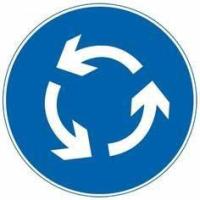1、What is the meaning of this sign?

A、turn right
B、one-way road
C、going straight only
D、straight-going lane
Answer:A
2、What is the max speed on muddy road?
A、15km/hr
B、20km/hr
C、40km/hr
D、30km/hr
Answer:D
3、When driving a motorized vehicle uphill, you should speed up and honk when you going to reach the top of the slope.
A、Right
B、Wrong
Answer:B
4、A motorized vehicle driver who drives after drinking is subject to a 12-point penalty.
A、Right
B、Wrong
Answer:A
5、In which situation the traffic police may detain the vehicle?
A、no vehicle registration papers
B、no insurance contract
C、no lable of environmental protection
D、no label of insurance
Answer:D
6、What is the max speed at sharp curve?
A、20km/hr
B、30km/hr
C、40km/hr
D、50km/hr
Answer:B
7、How to use lights when pulling over on road?
A、turn on the hazard lights
B、turn on the right-turn signal in advance
C、use the high and low beam lights alternately
D、not need to use any light to indicate
Answer:B
8、What is the meaning of this sign?

A、watch for pedestrians
B、crosswalk
C、village or town
D、primary school
Answer:C
9、When a motorcycle wades across the water, the braking efficiency of the brake does not change.
A、Right
B、Wrong
Answer:B
10、What should the driver do to follow other motor vehicles on a mountain road?
A、Closely follow the vehicle in front
B、Increase the safety distance
C、Reduce the vertical distance between vehicles
D、Try to overtake the vehicle in front as soon as possible
Answer:B
11、If a person escapes after causing a traffic accident and constitutes a crime, his driving license should be revoked and he is banned _____ from re-obtaining a driving license.
A、within 5 years
B、within 10 years
C、within 20 years
D、for lifetime
Answer:D
12、When overtaking on a rainy day, drivers should turn on headlamps and sound a long horn.
A、Right
B、Wrong
Answer:B
13、Traffic Signs and traffic markings are not traffic signals.
A、Right
B、Wrong
Answer:B
14、Stopping temporarily on the road should not obstruct the passing of other vehicles and Pedestrians.
A、Right
B、Wrong
Answer:A
15、When causing a road accident involving property damage, the parties to the accident may leave the scene if they have no dispute over the fact and cause.
A、Right
B、Wrong
Answer:A
16、When a motor vehicle stops in snow, which lamp should be turned on?
A、Front and rear fog lamps, clearance lamp and rear position lamp
B、Reverse lamp, clearance lamp and rear position lamp
C、Headlamp, clearance lamp and rear position lamp
D、Hazard lamps, clearance lamp and rear position lamp
Answer:D
17、When a motorcycle braking on a road covered by ice and snow, the driver should adopt point braking and prepare their feet for landing when braking.
A、Right
B、Wrong
Answer:A
18、If a motorized vehicle runs 50% faster than the specified speed limit, the driver is subject to a 3-point penalty.
A、Right
B、Wrong
Answer:B
19、If a motorized vehicle driver has caused a major accident in violation of the traffic regulations which has caused human death, the driver is subject to a prison term of more than 3 years.
A、Right
B、Wrong
Answer:B
20、Max speed when pass the narrow road or brisge is _______
A、50km/hr
B、40km/hr
C、30km/hr
D、60km/hr
Answer:C
21、After a tire blows out and before the driver can control the speed of the vehicle, he should refrain from using the foot brake to stop the vehicle. Otherwise, a horizontal swing of the vehicle can cause greater danger.
A、Right
B、Wrong
Answer:A
22、Which illegal conduct is subject to a 12-point penalty?
A、violate traffic lights
B、use falsified license plate
C、call or answer the mobile phone
D、violate prohibitive signs
Answer:B
23、The motorcycles should be inspected once every year when it exceeds ____ as from the date of registration.
A、1 year
B、2 years
C、3 years
D、4 years
Answer:D
24、What should the driver do when encountering a vehicle from the opposite direction on a road without a central line?
A、driving closly by the roadside
B、driving by the central of the road
C、reducing speed and driving by right side
D、run by using the lane for non-motorized vehicles
Answer:C
25、What is the meaning of this sign?

A、passing by the right side
B、passing by the left side
C、running to right side
D、running the roundabout
Answer:D